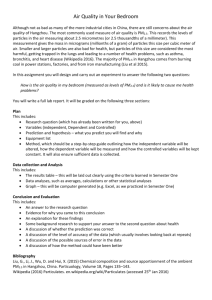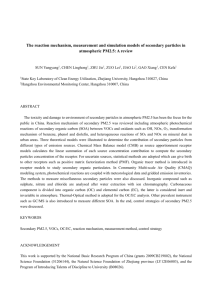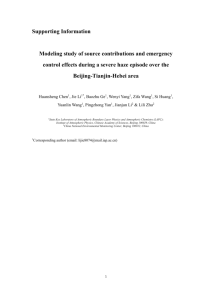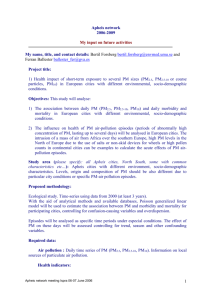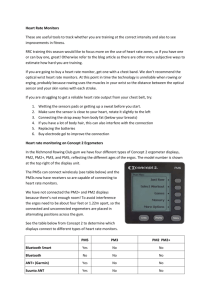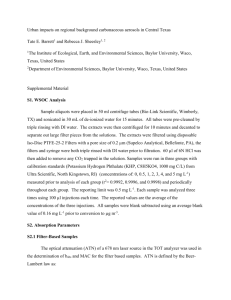The United States Environmental Protection Agency (US EPA) has
advertisement
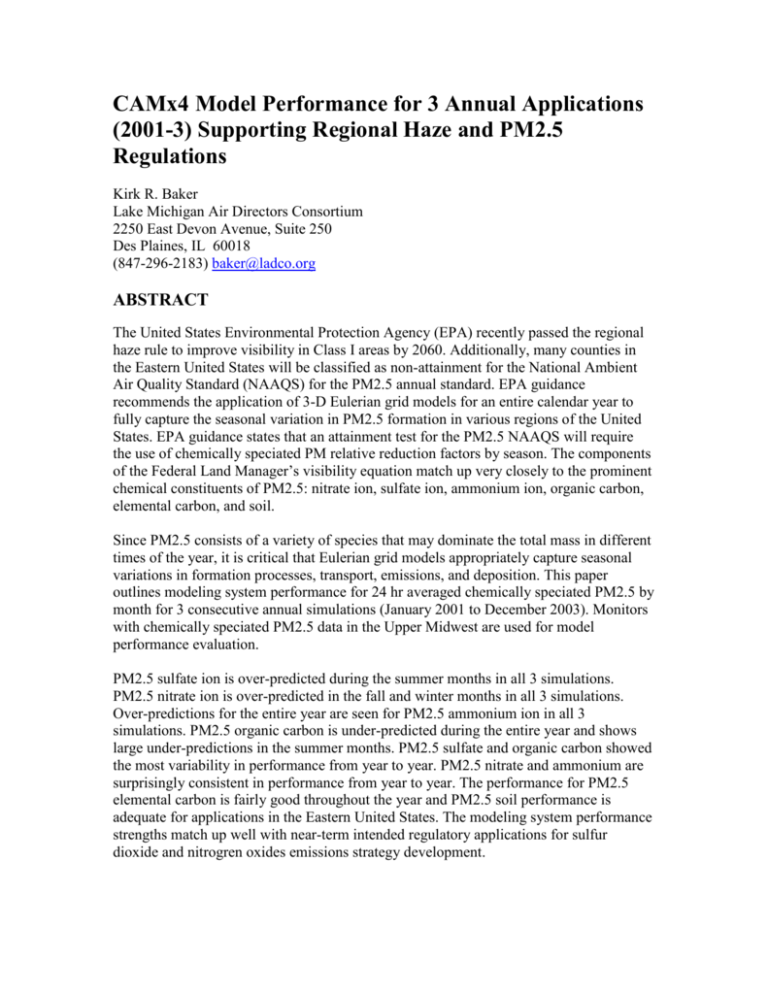
CAMx4 Model Performance for 3 Annual Applications (2001-3) Supporting Regional Haze and PM2.5 Regulations Kirk R. Baker Lake Michigan Air Directors Consortium 2250 East Devon Avenue, Suite 250 Des Plaines, IL 60018 (847-296-2183) baker@ladco.org ABSTRACT The United States Environmental Protection Agency (EPA) recently passed the regional haze rule to improve visibility in Class I areas by 2060. Additionally, many counties in the Eastern United States will be classified as non-attainment for the National Ambient Air Quality Standard (NAAQS) for the PM2.5 annual standard. EPA guidance recommends the application of 3-D Eulerian grid models for an entire calendar year to fully capture the seasonal variation in PM2.5 formation in various regions of the United States. EPA guidance states that an attainment test for the PM2.5 NAAQS will require the use of chemically speciated PM relative reduction factors by season. The components of the Federal Land Manager’s visibility equation match up very closely to the prominent chemical constituents of PM2.5: nitrate ion, sulfate ion, ammonium ion, organic carbon, elemental carbon, and soil. Since PM2.5 consists of a variety of species that may dominate the total mass in different times of the year, it is critical that Eulerian grid models appropriately capture seasonal variations in formation processes, transport, emissions, and deposition. This paper outlines modeling system performance for 24 hr averaged chemically speciated PM2.5 by month for 3 consecutive annual simulations (January 2001 to December 2003). Monitors with chemically speciated PM2.5 data in the Upper Midwest are used for model performance evaluation. PM2.5 sulfate ion is over-predicted during the summer months in all 3 simulations. PM2.5 nitrate ion is over-predicted in the fall and winter months in all 3 simulations. Over-predictions for the entire year are seen for PM2.5 ammonium ion in all 3 simulations. PM2.5 organic carbon is under-predicted during the entire year and shows large under-predictions in the summer months. PM2.5 sulfate and organic carbon showed the most variability in performance from year to year. PM2.5 nitrate and ammonium are surprisingly consistent in performance from year to year. The performance for PM2.5 elemental carbon is fairly good throughout the year and PM2.5 soil performance is adequate for applications in the Eastern United States. The modeling system performance strengths match up well with near-term intended regulatory applications for sulfur dioxide and nitrogren oxides emissions strategy development. INTRODUCTION The United States Environmental Protection Agency (EPA) recently passed the regional haze rule to improve visibility in Class I areas by 2060. Additionally, many counties in the Eastern United States will be classified as non-attainment for the National Ambient Air Quality Standard (NAAQS) for the PM2.5 annual standard. EPA guidance recommends the application of 3-D Eulerian grid models for an entire calendar year to fully capture the seasonal variation in PM2.5 formation in various regions of the United States. EPA guidance states that an attainment test for the PM2.5 NAAQS will require the use of chemically speciated PM relative reduction factors by season. The components of the Federal Land Manager’s visibility equation match up very closely to the prominent chemical constituents of PM2.5: nitrate ion, sulfate ion, ammonium ion, organic carbon, elemental carbon, and soil. Model performance is examined for chemically speciated PM2.5 rather than total PM2.5 mass because both PM2.5 NAAQS and Regional Haze modeling guidance stipulates the use of relative reduction factors by PM2.5 chemical specie to express changes in future year design values. The PM2.5 NAAQS is an annual standard and the Regional Haze rule defines visibility for 20% best and 20% worst days at each Class I area over multiple years so modeling system performance for multiple years is examined for appropriate response. The modeling system should be able to adequately capture the seasonal differences in ambient particulate concentrations and the year to year variability as well. The chemical transport model predicts particulate formation and removal processes, but the model performance results will be attributed to the entire modeling system since meteorological and emissions inputs are critical for appropriate estimates of particulates. This paper outlines modeling system performance for 24 hr averaged chemically speciated PM2.5 by month for 3 consecutive annual simulations (January 2001 to December 2003). Monitors with chemically speciated PM2.5 data in the Upper Midwest and Northeast United States are used for model performance evaluation. This type of evaluation will help identify the strengths and weaknesses of model performance by specie and season. METHODS The Comprehensive Air Quality Model with Extensions (CAMx4) version 4.11s uses state of the science routines to model particulate matter formation and removal processes over a large modeling domain. The model is applied with ISORROPIA inorganic chemistry, SOAP organic chemistry, RADM aqueous phase chemistry, and an updated CB4 gas phase chemistry module (ENVIRON, 2003). Meteorological input data for the photochemical modeling runs were processed using NCAR's 5th generation Mesoscale Model (MM5) version 3.6.1 (Dudhia, 1993; Grell et al, 1994). Important MM5 parameterizations and physics options applied to each summer include mixed phase (Reisner 1) microphysics, Kain-Fritsch 2 cumulus scheme, Rapid Radiative Transfer Model, Pleim-Chang planetary boundary layer, and the Pleim-Xiu land surface module. Surface and 3-D analysis nudging for temperature and moisture were only applied above the boundary layer. Analysis nudging of the wind field was applied above and below the boundary layer. These parameters and options were selected as an optimal configuration for the Upper Midwest based on extensive sensitivity simulations (Johnson, 2003; Baker 2004a). Emissions data were processed using EMS-2003 (Janssen, 1998). Outputs from EMS2003 include a coordinate-based elevated point source file and gridded emissions estimates for low-point, area, mobile, and biogenics sources. Anthropogenic emission estimates were made for a weekday, Saturday, and Sunday for each month. The biogenic emissions are day-specific. Volatile organic compounds are speciated to the Carbon Bond IV (CB4) chemical speciation profile (Gery et al., 1989). The point and area source inventory is based on the 2002 National Emission Inventory. On-road emissions are estimated with MOBILE6. The default temporal tables were modified to represent a more complex distribution of vehicle miles traveled for the weekend. Off-road emissions are estimated with the latest release of EPA’s NONROAD model. Anthropogenic emissions inputs for 2001 and 2003 were not grown or adjusted from the 2002 inventory. Biogenic emissions are estimated with EMS-2003 using BIOME3/BEIS3 and the BELD3 landuse dataset. Other inputs to the biogenic emissions model include hourly satellite photosynthetically activated radiation (PAR) and 15 m temperature data output from MM5. Ammonia emissions are based on the latest version of Carnegie Mellon University’s (CMU) ammonia model (July 2004 version) using 2002 census of agriculture data. CMU ammonia emissions estimates were not used from the following categories: humans, dogs, cats, and deer. The photochemical model uses 11 landuse categories to describe the surface. The landuse file is based on BELD3 1 km data. The 1 km data was aggregated to the appropriate grid resolution for photochemical modeling. Surface roughness varies by season and landuse category. Boundary conditions represent pollution inflow into the model and initial conditions provide an estimation of pollution that already exists. In the past a spin-up period of 2 to 3 days was used to eliminate initial condition effects for ozone modeling. CAMx4 particulate source apportionment (PSAT) runs show PM2.5 sulfate ion, nitrate ion, and ammonium ion contributions from initial concentrations reduce below 0.05 µg/m3 by the 7th day of the episode. PM2.5 elemental carbon, PM2.5 soil, and coarse mass have less than 1 ng/m3 contribution from initial concentrations on the first day of the model episode. The annual simulations have 2 weeks of spin-up to minimize initial condition influence. The initial and boundary conditions are based on seasonal averaged species output from an annual application of the global chemical transport model GEOS-CHEM. Where an initial or boundary concentration is not specified for a pollutant the model will default to a near-zero concentration. All models are applied with a Lambert projection centered at (-97, 40) and true latitudes at 33 and 45. The photochemical modeling domain consists of 97 cells in the X direction and 90 cells in the Y direction covering the Central and Eastern United States with 36 km grid cells (Figure 1). The meteorological modeling domain covers the entire continental United States with a 36 km grid, consisting of 165 cells in the X direction and 129 cells in the Y direction. CAMx4 is applied with the vertical atmosphere resolved with 16 layers up to approximately 15 kilometers above ground level. Output from the chemical transport model is compared to 24 hr averaged chemically speciated PM2.5 measurements taken from a variety of networks: IMPROVE, EPA Speciation Trends, and CASTnet Visibility. The monitor locations used for model performance are shown in Figure 1. Figure 1. CAMx4 36 km modeling domain and stations included in model performance evaluation Organic material is estimated from organic carbon using the 1.4 factor, which is based on the assumption that carbon accounts for 70% of the organic mass. Recent literature recommends a factor of 1.6 0.2 for urban aerosol and 2.1 0.2 for non-urban areas that would see more aged aerosol (Tombach et al, 1999). A default value is still needed since the relative urban-ness of a site is usually not reported with monitor data. The current 1.4 factor may not be the best approach, especially for CASTnet and IMPROVE data that are primarily collected at rural sites, but is used in this analysis. Table 1. Model Performance Metrics Mean Bias Gross Error Fractional Bias Fractional Gross Error MB MAGE FB M ( P 1 N M | P 1 N M FE N 1 NM 1 NM j Oi j ) j Oi j | i i 1 j 1 N M i i 1 j 1 N M Pi j Oi j j j i Oi 2 P i 1 j 1 N M Pi j Oi j j j i Oi 2 P i 1 j 1 *P=model prediction; O=observation; N=number of days; M=number of monitors Model performance evaluation methodology for PM2.5 and Regional Haze is described in the U.S. Environmental Protection Agency document “Guidance for Demonstrating Attainment of Air Quality Goals for PM2.5 and Regional Haze” (US EPA, 2001). The guidelines describing good model performance for chemically speciated PM2.5 are based on a few early modeling applications that were limited in domain and episode length. For these reasons, the suggested guidelines for model performance to support regulatory applications are not included in the analysis. Performance metrics used to describe model performance for PM2.5 species include mean bias, gross error, fractional bias, and fractional error (Table 1). The bias and error metrics are used to describe performance in terms of the measured concentration units (g/m3). PM2.5 chemical specie concentrations are skewed toward very small values, but some species have fairly large concentrations in particular seasons. Fractional bias and fractional error facilitate inter-comparison of the performance of different PM2.5 chemical species and the differences in performance between different seasons of a single specie. When the fractional error approaches 0 the model performance is best. The maximum value of fractional error is 2, which suggests very poor performance. Fractional bias may be positive or negative, and is best when close to zero and worst when close to ± 2. Even though the distribution of PM2.5 is log-normal, the data is not transformed for this analysis. The model attainment tests outlined by US EPA for the PM2.5 NAAQS and Regional Haze rule require relative reduction factors to be applied to actual concentrations and not transformed concentrations. No minimum value is used to eliminate data points for the purposes of this analysis. RESULTS & DISCUSSION Mean bias, gross error, fractional bias, and fractional error metrics are shown in Table 3 for the 2002 calendar year. The results for 2001 and 2003 are not included in tabular form due to their similarity to the 2002 results. The variation between years by month for PM2.5 sulfate, nitrate, ammonium, and organics are shown in Figure 2. Table 3. Model Performance Results for Annual 2002 Simulation by Month month JAN FEB MAR APR MAY JUN JUL AUG SEP OCT NOV DEC month JAN FEB MAR APR MAY JUN JUL AUG SEP OCT NOV DEC N 961 975 1063 1172 1184 1057 1182 1126 1297 1354 1272 1203 EC 0.43 0.35 0.26 0.17 0.18 0.10 0.16 0.23 0.24 0.37 0.34 0.27 OC -1.33 -1.68 -1.14 -1.36 -1.89 -3.78 -5.82 -3.71 -2.35 -1.05 -1.96 -2.34 N 961 975 1063 1172 1184 1057 1182 1126 1297 1354 1272 1203 EC 0.49 0.42 0.31 0.22 0.22 0.03 0.18 0.25 0.33 0.47 0.45 0.34 OC -0.23 -0.29 -0.30 -0.34 -0.48 -0.77 -0.87 -0.71 -0.44 -0.28 -0.48 -0.37 Mean SO4 -0.03 0.15 0.82 0.89 1.45 0.68 -0.31 0.37 1.13 1.85 0.57 -0.36 Bias NO3 1.84 1.33 1.03 0.91 -0.08 -0.02 -0.24 -0.04 0.58 1.44 2.52 3.32 Fractional Bias SO4 NO3 -0.10 0.41 -0.01 0.36 0.15 0.25 0.22 -0.15 0.35 -0.64 0.19 -0.83 0.04 -1.09 0.16 -0.94 0.28 -0.23 0.45 0.28 0.17 0.55 -0.15 0.65 NH4 0.70 0.68 0.75 0.79 0.53 0.44 -0.07 0.29 0.71 1.19 1.13 0.93 SOIL 0.53 0.44 0.20 -0.05 -0.06 -0.08 -0.35 -0.10 0.12 0.36 0.37 0.36 EC 0.52 0.45 0.33 0.29 0.28 0.31 0.35 0.35 0.35 0.44 0.43 0.41 OC 2.35 2.66 1.81 1.87 2.22 3.89 5.89 3.81 2.75 1.79 2.42 2.89 NH4 0.37 0.44 0.43 0.38 0.34 0.27 0.13 0.31 0.46 0.74 0.58 0.46 SOIL 0.68 0.56 0.18 -0.21 -0.22 -0.19 -0.25 -0.20 0.06 0.47 0.49 0.40 EC 0.60 0.59 0.53 0.47 0.47 0.49 0.55 0.53 0.52 0.62 0.58 0.52 OC 0.52 0.60 0.56 0.55 0.60 0.83 0.90 0.75 0.58 0.54 0.64 0.59 Gross SO4 1.10 0.74 1.30 1.43 1.98 2.17 2.59 2.44 2.18 1.98 1.19 1.05 Error NO3 2.20 1.63 1.46 1.42 0.70 0.78 0.62 0.51 0.95 1.73 2.66 3.49 Fractional Error SO4 NO3 0.44 0.70 0.33 0.70 0.34 0.77 0.38 0.92 0.46 1.01 0.43 1.17 0.44 1.33 0.48 1.27 0.43 1.09 0.50 0.99 0.43 0.86 0.43 0.81 NH4 0.86 0.76 0.86 0.94 0.69 0.86 0.84 0.85 0.99 1.23 1.18 1.03 SOIL 0.59 0.56 0.37 0.44 0.39 0.51 0.77 0.59 0.53 0.49 0.53 0.54 NH4 0.45 0.49 0.47 0.46 0.43 0.44 0.46 0.54 0.57 0.75 0.61 0.51 SOIL 0.87 0.85 0.72 0.72 0.69 0.75 0.80 0.77 0.74 0.85 0.86 0.77 Figure 2. Monthly Bias for Each Annual Simulation by PM2.5 chemical specie (top left clockwise): sulfate, nitrate, ammonium, organics Figure 3. Fractional Bias v. Fractional Error metrics by PM2.5 chemical specie for all 3 annual simulations Figure 4. Fractional Bias v. Fractional Error metrics by month for PM2.5 chemical species (top left clockwise): sulfate, nitrate, ammonium, organics Particulate sulfate bias and error are highest in the summer months, which coincide with the highest measured concentrations of sulfate. Particulate sulfate performance varies quite a bit in the summer months by annual simulation. This variability is expected due to the relationship between sulfate formation and meteorology. The over-prediction bias is seen in all 3 annual simulations, but highest in 2003. An interesting feature of sulfate performance is a slight over-prediction bias in September 2001 and a similar overprediction in October 2002. The summer over-predictions are likely due to the lack of sub-grid convective rainfall in CAMx4 that would eliminate more sulfates from the model since it rains out rather quickly. The slight over-predictions in the fall are likely related to the emissions modeling not appropriately capturing scheduled shutdowns of electrical generating units. The over-predictions in 2003 may be due to using 2002 sulfur dioxide emissions for 2003 and over-stating real 2003 emissions. PM2.5 nitrate ion performance is interesting because the mean bias and gross error metrics seem opposite to the fractional error and fractional bias. The mean bias and gross error are very low in the summer and higher in the winter. The fractional error and fractional bias are highest in the summer and lower, but still fairly high in the winter. The distribution of observed nitrate concentrations is skewed heavily towards very low numbers, particularly in the summer when nitrate formation is not favored by meteorology. In the case of nitrate, the fractional bias and error are a better representation of the distribution of prediction-observation pairs. Nitrate is over-predicted in the winter much more than in summer, but little relationship exists between predictions and observations in the summer even though observations are small. Little variation in nitrate performance is seen in each month for the 3 annual simulations. The pattern of performance is very similar, suggesting a systematic cause of degraded model performance. It is likely the over-prediction of nitrate is related to excess ammonia in the model. Performance for the PM2.5 ammonium ion is consistent in all 3 annual simulations. Year to year variation by month is very minimal. It is generally over-predicted in all 12 months, with error highest in the fall and early winter. This suggests that there is too much ammonia in the modeling system. It is not clear whether emissions are too high, deposition is not rapid enough, or other ammonia partitioning processes are not being appropriately modeled. The trends in bias and error for PM2.5 organics are similar over the 3 annual simulations, but show greater variability than most of the other PM2.5 species. PM2.5 organics are under-predicted in all months, most notably in the summer months. The error is also high for all months and highest in the summer. Model prediction is best in the colder months when ambient particulate organics tend to be dominated by primary emissions rather than formation from photochemical reactions. The under-prediction of particulate organics in the warmer months is partially due to missing formation processes for secondary organics: yields from isoprene, yields from sesquiterpenes, polymerization, and acidcatalyzed formation. PM2.5 elemental carbon bias is low for all months for all 3 years. Overall, PM2.5 elemental carbon performance is good. PM2.5 soil bias tends to be under-predicted in the summer and over-predicted in the winter. Very little PM2.5 soil is observed on filters in the Upper Midwest and tends to be dominated by global scale dust events that are not included in the modeling system. CONCLUSION Sulfate ion model performance appears good in the summer months, which is important since this is when concentrations are highest. Nitrate ion concentrations are highest in the winter and model performance for nitrate is best during the winter. Ammonium is overpredicted for the entire year, suggesting too much ammonia is in the modeling system. The apparent excess of free ammonia may over-state the effects of reducing nitrate ion from the reduction of nitrogen oxide emissions. This is hypothesized because any free nitric acid in favorable meteorological conditions (low temperatures and high humidity) will partition into the particulate phase. The excess ammonia in the modeling system may also reduce the chemical transport model responsiveness to changes in ammonia emissions. The modeling system does a good job of predicting elemental carbon. It is usually measured in very low concentrations and the modeling system does a good job estimating that specie through the year. Performance for soil is poor, but given the fact there is little PM2.5 soil measured on filters in the eastern United States the regulatory importance of this specie is minimal compared to sulfate, nitrate, and organic carbon. The performance for organic carbon is poor. The science of secondary organic aerosol formation is still evolving so it is probably not realistic for the modeling system to accurately predict organic carbon when the formation processes are still not fully understood. Recent research has suggested several new or refined pathways of secondary aerosol formation that are not currently in the modeling system: yields from isoprene, yields from sesquiterpenes, polymerization, and acid catalyzed reactions. Since these processes are not in the modeling system it seems appropriate that the modeling system is significantly under-predicting particulate organics. It is critical that new science be implemented into chemical transport models so regulators can determine what part of particulate organic carbon is possible to control with anthropogenic emissions reduction scenarios. In the near term, most PM2.5 and Regional Haze control plans are likely to target emission reductions of sulfur dioxide and nitrogen oxides, which match up well with the current strengths of the modeling system: sulfate and nitrate ions. The uncertainties surrounding particulate organic carbon formation may not be critical to regulators right now, but work needs to continue to improve modeling performance for future applications. REFERENCES Baker, K. Meteorological Modeling Protocol For Application to PM2.5/Haze/Ozone Modeling Projects, 2004. Baker, K. Application of Multiple One-Atmosphere Air Quality Models Emphasizing PM2.5 Performance Evaluation, presented at the Air & Waste Management Association 2004 Annual Meeting, Indianapolis, IN, 2004b. Dudhia, J., A nonhydrostatic version of the Penn State/NCAR mesoscale model: Validation tests and simulation of an Atlantic cyclone and cold front, Mon. Wea. Rev., 121, 1493-1513, 1993. ENVIRON International Corporation. 2003. User's Guide Comprehensive Air Quality Model with Extensions (CAMx4) Version 2.00. ENVIRON International Corporation, Novato, California. November. FLAG. 2000. Federal Land Manager’s Air Quality Related Values Workgroup (FLAG) Phase I Report. (http://www2.nature.nps.gov/ard/flagfiee/AL.doc). Grell, G. A.; J. Dudhia, and D. R. Stauffer, A description of the Fifth Generation Penn State/NCAR Mesoscale Model (MM5), NCAR Tech. Note, NCAR TN-398-STR, 138 pp., 1994. Janssen, M., and C. Hua. 1998. Emissions Modeling System-95 User's Guide. http://www.ladco.org/emis/guide/ems95.html. Johnson, M., Meteorological Modeling Protocol: IDNR 2002 Annual MM5 Application, 2003. Seigneur, C., B. Pun, P. Pai, J. F. Louis, P. Solomon, C. Emery, R. Morris, M. Zahniser D. Worsnop, P. Koutrakis, W. White and I. Tombach, 2000. Guidance for the performance evaluation of three-dimensional air quality modeling systems for particulate matter and visibility, J. Air Waste Manage. Assoc., 50, 588-599. Tombach, I., Seigneur, C., 1999. Review of the EPA Draft Document "Guidance For Demonstrating Attainment of Air Quality Goals for PM2.5 and Regional Haze". Wilkinson, J., Loomis, C., Emigh, R., McNalley, D., Tesche, T., 1994. Technical Formulation Document: SARMAP/LMOS Emissions Modeling System (EMS-95). Final Report prepared for Lake Michigan Air Directors Consortium (Des Plaines, IL) and Valley Air Pollution Study Agency (Sacramento, CA). U.S. Environmental Protection Agency, Draft Guidance on the use of Models and Other Analyses in Attainment Demonstrations for the 8-hour Ozone NAAQS, EPA-454/R-99004, Office of Air Quality Planning and Standards, Research Triangle Park, NC, 1999. U. S. Environmental Protection Agency, Guidance for Demonstrating Attainment of Air Quality Goals for PM2.5 and Regional Haze, Draft 2.1, January, 2001. U. S. Environmental Protection Agency, Appendix E: Speciated Modeled Attainment Test Documentation; Guidance for Demonstrating Attainment of Air Quality Goals for PM2.5 and Regional Haze, 2002. U. S. Environmental Protection Agency, Guidance for Tracking Progress Under the Regional Haze Rule, EPA-454/B-03-004, Office of Air Quality Planning and Standards, Research Triangle Park, NC, 2003a. U. S. Environmental Protection Agency, Guidance for Estimating Natural Visibility Conditions Under the Regional Haze Program, EPA-454/B-03-005, Office of Air Quality Planning and Standards, Research Triangle Park, NC, 2003b. vanLoon, G., Duffy, S., 2000. Environmental Chemistry, Oxford University Press, Inc., New York.
